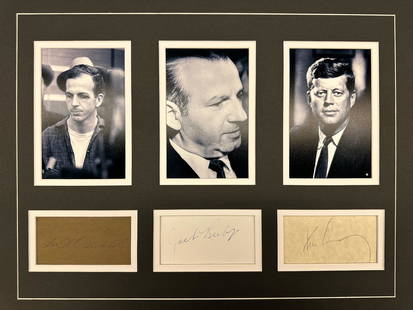
T. Roosevelt Custom Display Featuring WH Loveseat Swatch, Likely Part of Mamie Eisenhower
Similar Sale History
View More Items in Presidential & First Lady Memorabilia

Related Presidential & First Lady Memorabilia
More Items in Presidential & First Lady Memorabilia
View MoreRecommended Historical Memorabilia
View More






Item Details
Description
T. Roosevelt Custom Display Featuring WH Loveseat Swatch, Likely Part of Mamie Eisenhower Renovations. CAG Encapsulated.
Swatch, 1.25" x .75", excised from a length of green silk brocade once covering a White House loveseat, likely a remnant from renovations undertaken by 26th U.S. President Theodore Roosevelt in 1902, and removed under the direction of First Lady Mamie Eisenhower (1896-1979) in 1954. Encapsulated by CAG, measuring 2.375'' x 3.375''.
This piece of fabric was once part of a larger fragment decorated with stylized acanthus leaves measuring approximately 21ʺ x 42." Photographs of the original fabric and a tag associated with the piece are included for reference. The tag indicated that the fabric corresponded with the "1114 Love Seat" with a mahogany finish and a furnished cover. The "Customer" is listed as "The White House," and it bears the stamped dates of September 4, 1954, and October 29, 1954, presumably when the Roosevelt silk was removed. Reproduction images of the White House State Dining Room and Green Room as they appeared following the Roosevelt restoration show where this loveseat might have once been placed.
In 1902, Theodore Roosevelt embarked on an extensive remodeling of the "People's House." Plans had been in the works for years to build a new White House or expand the original. TR wanted to remove the Victorian decor which had accumulated over the previous thirty years in order to return the White House to its Federal-style roots.
Work began in June under the supervision of the New York City architectural firm McKim, Mead, and White, with Charles McKim supervising the project. McKim held little regard for historical elements and worked fast to strip the house of most of its floors and cover over old walls with new plaster. By the end of the year, the job was complete, although the result was more Georgian than Federal.
McKim's most significant alterations were to remove the original grand stair in the west end of the Cross Hall—what is today the north side of the State Dining Room—and make the side stair by the Entrance Hall a grander affair (to be redone again by Truman). He also added bathrooms on the second floor and installed a new elevator and electric lights everywhere to replace most of the old gaslight fixtures. Roosevelt's proclivity for green is documented here http://www.whitehousemuseum.org/special/renovation-1902.htm especially in the Green Room as well as the State Dining Room which shows some very similar fabrics (see attached pictures for reference.)
From late 1948 to mid-1952, the White House was completely gutted and reconstructed with modern materials. While it was rebuilt on the same general plan, the house was very different, with two new basement levels and the addition of approximately seventy new rooms and a central air-conditioning system. The Commission on the Renovation of the Executive Mansion had set aside $200,000 to cover all interior work, from painting the walls to restoring or replacing old furniture. B. Altman & Co., a New York City department store, received the contract for the interior furnishings and committed to complete all work at cost.
In the "New York Times," former First Lady Bess Truman declared that "Mrs. Eisenhower will step into fewer household headaches than any of her predecessors. She will move into the best-looking White House since Abigail Adams crossed its threshold...."
First Lady Mamie Eisenhower nevertheless made significant contributions to the White House interior during her husband's eight years in office (1953-1961), though her efforts are often overshadowed by those of her successor, Jacqueline Kennedy. Jackie's campaign to "restore" the White House with historically appropriate furnishings was highly publicized, and her televised walking tour of refurbished White House rooms garnered thousands of viewers.
In the Eisenhower era, Chief Usher Howell Crim requested the traditional $50,000 congressional appropriation given to each administration for purchasing and repairing furnishings for the White House, Congress denied the request. Instead, Crim accessed $200,000 left over from a 1946 appropriation of $680,000 for improvements to the Executive Mansion, before the renovation under President Harry S. Truman and its appropriation had eliminated the need for some of the improvements.
Mamie Eisenhower was disappointed at the limitations placed upon her, but she had decades of experience in creating a home for herself and her husband with furnishings chosen by others. The White House was their thirty-sixth residence together according to Mamie's calculations. Determined to make the mansion comfortable for her family, including grandchildren who visited frequently, Eisenhower established a comfortable master bedroom in Bess Truman’s former sitting room. She also accepted donations of furniture, especially if it was related to former residents of the White House, including a sofa and three chairs from Abraham Lincoln’s tenure, and a classical mahogany sofa used by President James Monroe in the White House.
Provenance:
This fabric from the White House loveseat was found in the attic of a Washington home wrapped up in a 1944 newspaper. It was found along with a tablecloth made from the scenery curtain from Ford’s Theatre that was in use on the night Abraham Lincoln was assassinated in April 1865. All of the notes, emails, photos, and newspaper documentation relating to these items are kept in perpetuity in the University Archives' provenance file. Sourced from and certified authentic by University Archives, one of the foremost authorities of historical relics and artifacts.
This item comes with a Certificate from John Reznikoff, a premier authenticator for both major 3rd party authentication services, PSA and JSA (James Spence Authentications), as well as numerous auction houses.
WE PROVIDE IN-HOUSE SHIPPING WORLDWIDE!
Buyer's Premium
- 25%
T. Roosevelt Custom Display Featuring WH Loveseat Swatch, Likely Part of Mamie Eisenhower
Shipping & Pickup Options
Item located in Wilton, CT, usPayment

Auction Curated By












































![Benjamin Harrison Fine Signed White House Card: Benjamin Harrison[Washington, DC], Late 19th CenturyBenjamin Harrison Fine Signed White House CardDSAn engraving of the White House bearing the signature of Benjamin Harrison at the bottom, boldly exe](https://p1.liveauctioneers.com/6306/327579/176471576_1_x.jpg?height=310&quality=70&version=1714074043)






![Abraham Lincoln Relic Pairing- Death Room Wallpaper & Red Room Swatch: Abraham Lincoln[Washington, D.C.], ca. 1860sAbraham Lincoln Relic Pairing- Death Room Wallpaper & Red Room SwatchRelicTwo wallpaper swatches, the first being attributed to the Lincoln-era "Red Ro](https://p1.liveauctioneers.com/6306/327579/176471612_1_x.jpg?height=310&quality=70&version=1714074043)



![10 Days After His Assassination JFK Signed W. H. letter, Fantastic! Among JFK's Last Acts in White H: John F. Kennedy[Washington, D.C.], December 2, 196310 Days After His Assassination JFK Signed W. H. letter, Fantastic! Among JFK's Last Acts in White House Post Dated Before Dallas TripTLSJOHN F. KENN](https://p1.liveauctioneers.com/6306/327579/176471594_1_x.jpg?height=310&quality=70&version=1714074043)








![Reagan Presidential "Camp David" Pickard China Dinner Plate: Presidential[Camp David], n.d.Reagan Presidential "Camp David" Pickard China Dinner PlateTablewareA Pickard China (Antioch, Illinois) dinner plate, almost certainly dating from the Reagan ad](https://p1.liveauctioneers.com/6306/327579/176471666_1_x.jpg?height=310&quality=70&version=1714074043)













